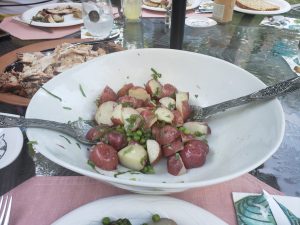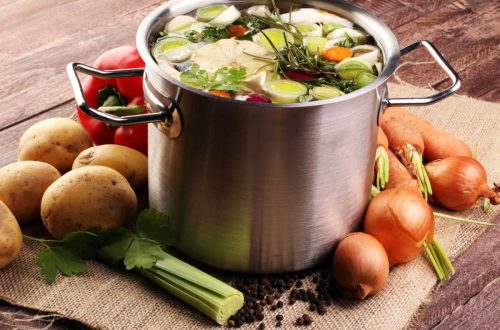The Potato Salad in Your DNA
It’s finally summer in the northern climes. With hot nights, who wants to work over a stove inside? It’s grilling season, and that also means potato salad. Talk to almost anyone, and you can learn about their family potato salad.
In my 1950s youth, this time of year meant haying season, a communal farming activity that often included meals. Chapter 1 of the 1959 Farm Journal’s Country Cookbook, the farm wife’s Bible, begins with the sentence: “Country men believe that some of the world’s best eating comes with this trio – meat, potatoes, and gravy….” Except that in the Corn Belt summer, it’s too hot for roasting beef and making gravy. So those haying season meals usually featured cool foods: often luncheon meats together with a couple of salads that could be made in advance in the cooler morning hours.
Potato salad was a staple and benefitted the harried farm cook. The ingredients were usually in the larder; it filled up hungry farmers; and it tasted great. Almost every version comprised the basic potatoes, green onions, hard-boiled eggs, mayonnaise, vinegar, and celery seed. It wasn’t until my high school years that I happened upon Hot German Potato Salad. Add bacon to potato salad? What’s not to like? In the Farm Journal Country Cookbook, the recipe swapped bacon, cider vinegar, and sugar for the mayonnaise. And, it added a recipe option: a half cup of chopped dill pickle. For lovers of everything bacon, it was a mindblower.
What is your version of potato salad? Where does it come from and why? Would you try something new this summer and maybe start a new family tradition? There are clearly any number of versions. Just recently, the chef Pioneer Woman announced a version made with mashed potatoes. What might you try?
It all begins with the potatoes, the blank canvas for your masterpiece. Your palette is the remaining ingredients: the binding agents (think mayo or oil and vinegar) and mix-ins (all the rest from herbs and celery and onions to chopped olives or pickles). Don’t neglect color. And keep in mind what you’re serving it with and, of course, what your family or guests would prefer.
 For a simple main such as burgers or hot dogs, the potato salad might feature a fully blown flavor explosion. If you’re accompanying a main dish with flavors that deserve a spotlight, you might make a potato salad that’s more subtle. For a recent meal featuring maple-smoked turkey breast, we served a light potato salad with mint and peas (pictured) that did not overpower the turkey. The red potatoes, peas, and herbs added color to the plate.
For a simple main such as burgers or hot dogs, the potato salad might feature a fully blown flavor explosion. If you’re accompanying a main dish with flavors that deserve a spotlight, you might make a potato salad that’s more subtle. For a recent meal featuring maple-smoked turkey breast, we served a light potato salad with mint and peas (pictured) that did not overpower the turkey. The red potatoes, peas, and herbs added color to the plate.
I found versions from Spain (heavy on the smoked paprika), Norway (with pickled herring), France (with a simple vinaigrette, tarragon, and parsley), and Russia (with beets). I also found one that combined potatoes with fresh corn and basil and another with onion and bleu cheese. If you’re trying a new version, the world is your oyster.
Here are some things to think about:
Potatoes: As your base, you’d probably want a yellow-fleshed (Yukon Gold) or red-skinned potato. They hold together much better during the boiling process. Russets are likely to fall apart in your salad.
Dressing (the binder): Consider the flavors you’re seeking or trying to enhance. For something light, Just oil and vinegar. For the acid (vinegar) part, would you like to add a little zest or substitute some citrus such as lemon or lime juice? Tradition calls for mayonnaise as a binder, but you could use sour cream or yogurt sweetened with a little sugar or honey.
Flavor profile: Here’s where you can go wild with what you may have fresh from your herb garden or left over from another recipe. Common choices include parsley, oregano, dill, tarragon, capers, olives, and mint.
Vegetable/protein mix-ins are a place to be creative. Bell pepper, red onion, scallions, chives, carrots, shallots, celery, hard-boiled eggs, bacon, olives, and gherkins or dill pickles are some standard adds. But how about capers, peas, beets, herring, bleu cheese, gorgonzola, cheddar, or feta? I’ve even seen suggestions for almonds or walnuts for flavor and crunch. Mix-ins are the place to add color.
I’d like to know what potato salad might be in your DNA and where it came from. Is there a story that goes along with it? Do you do something different today? Why the change? If you’ve experimented with new twists, let us know what happened. Please comment below!


